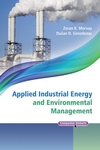Applied Industrial Energy and Environmental ManagementISBN: 978-0-470-69742-9
Hardcover
456 pages
December 2008, Wiley-IEEE Press
 |
||||||
Preface.
Introductory Chapter: Framework for Energy and Environmental Management in Industry.
1. Introduction.
2. Energy Use by Industrial Operations.
3. Environmental Impacts of Industrial Operations.
4. End Use Energy Efficiency.
5. Efficiency of Using Raw Materials.
6. Global Energy Policy Framework.
7. Energy and Environmental Policies.
7.1 Integrated Pollution Prevention and Control (IPPC).
7.2 Energy Markets Deregulation and Liberalization.
7.3 Consumers’ Choice in the Liberalized Energy Market.
7.4 Emissions Trading.
7.5 Compulsory Energy Efficiency Programs.
7.6 Voluntary Programs.
8. Industries’ Self-Motivation for Effective Energy and Environmental Performance.
9. Environmentally Responsible Investing.
10. Where to Look for Energy and Environmental Performance Improvements.
11. Bibliography.
Part I: Energy and Environmental Management System in Industry (EEMS).
1. Introducing the Energy and Environmental Management System.
1.1 Introduction.
1.2 Definition of terms.
1.3 Energy and Environmental Management System.
1.4 Objectives of Energy and Environmental Management.
1.5 Dynamics of Energy and Environmental Management.
1.6 Human Aspects of Energy and Environmental Management.
1.7 Initiating Training, Awareness and Motivation Programs.
1.8 Bibliography.
2. The Energy and Environmental Management Concept.
2.1 Introduction.
2.2 Interactions between Energy and Production.
2.3 Energy Cost Centers.
2.4 Assigning Responsibilities for Energy and Environmental Performance.
2.6 Effective Use of Energy and Environmental Performance Indicators.
2.7 Concept of Energy and Environmental Management System.
2.8 Context of Energy and Environmental Management.
2.9 Bibliography.
3. Relationship between Energy Use and Production Volume.
3.1 Introduction.
3.2 Energy/Production Relationship by Design.
3.3 Energy/Production Relationship by Standard Operational Procedure.
3.4 Presenting the Dynamics of the Energy/Production Relationship by Scatter Diagram.
3.5 Interpretation of Energy/Production Data Pattern on the Scatter Diagram.
3.6 Statistical Methods for Energy/Production Variability Analysis.
3.7 Meaning and Use of the Regression Line in Energy Performance Evaluation.
3.8 Summary of Presenting and Analyzing the Energy/Production Relationship.
3.9 Bibliography.
4. Evaluating the Performance of Energy and Environmental Management Practice.
4.1 Evaluation of Past Performance.
4.2 Energy and Environmental Auditing.
4.3 Evaluating Organizational Aspects.
4.4 Evaluating Operational Aspects.
4.5 Setting a Baseline for Monitoring Performance Improvements.
4.6 Setting Initial Targets for Performance Improvement.
4.7 Monitoring Energy and Environmental Performance.
4.8 Verifying Performance Improvements – CUSUM Technique.
4.9 Moving Toward Targets – Process of Change.
4.10 Bibliography.
5. Implementation of the Energy and Environmental Management System.
5.1 Introduction.
5.2 Phases of EEMS Implementation Process.
5.3 Preparation and Planning.
5.4 Implementation Plan.
5.5 EEMS Operation.
5.6 Learning Through EEMS Operation.
5.7 Continuity and Communication.
5.8 Integration of EEMS with Business Management System.
6. Energy and Environmental Management as a Driver for Integrated Performance Management.
6.1 Introduction.
6.2 Integrated Performance Management in Operations.
6.3 Strategic Aspects of Performance Management.
6.4 Integrated Performance Measurement System.
6.5 Integrated Performance Management.
6.6 Conclusion.
6.7 Bibliography.
Part II: Engineering Aspects of Industrial Energy Management.
1. Introduction to Industrial Energy Systems.
1.1 Introduction.
1.2 Industrial Energy Systems Analysis.
2 Industrial Steam System.
2.1 System Description.
2.1.1 Boilers.
2.3 Principles of Performance Analysis.
2.4 Analysis of Boiler Performance.
2.5 Factors Influencing Boiler Performance.
2.6 Opportunities for Boiler Performance Improvement.
2.7 Software for Boiler Performance Analysis.
2.8 Boiler Performance Monitoring.
2.9 Steam Distribution and Condensate Return System.
2.10 Condensate Return System.
2.11 Environmental Impacts.
2.12 Bibliography.
3. Industrial Electric Power System.
3.1 Introduction.
3.2 Description of Industrial Electric Power Systems.
3.3 Basic Terms.
3.4 Tariff System.
3.5 Main Components of Industrial Electric Power Systems.
3.6 Performance Assessment of Industrial Electric Power Systems.
3.7 Performance Improvement Opportunities.
3.8 Maintenance Considerations.
3.9 Performance Monitoring.
3.10 Environmental Impacts.
3.11 Bibliography.
4. Compressed Air System.
4.1 System Description.
4.2 Performance Analysis.
4.3 Performance Improvement Opportunities.
4.4 Performance Monitoring.
4.5 Example: Detailed Energy Audit of Compressed Air System.
4.6 Example: Comparison of Load/Unload and Pump-up Tests.
4.7 Bibliography.
5. Refrigeration System.
5.1 Description of System.
5.2 Performance Definitions.
5.3 Performance Analysis.
5.4 Performance Improvement Opportunities.
5.5 Performance Monitoring.
5.6 Example: Improvement of ChilledWater System Operation.
5.7 Bibliography.
6. Industrial Cogeneration.
6.1 System Description.
6.2 Principles of Operation.
6.3 Types of Industrial Cogeneration Plants.
6.4 Operational Modes of Cogeneration Systems.
6.5 Performance Definition.
6.6 Factors Influencing Performance.
6.7 Economic Aspects of Cogeneration as a Performance Improvement Measure.
6.8 Performance Assessment.
6.9 Performance Monitoring and Improvement.
6.10 Environmental Impacts 415.
6.11 Case Study: Drying Kiln (Gas Turbine Operation Philosophy Improvement).
6.12 Bibliography.
Part III: Toolbox – Fundamentals for Analysis and Calculation of Energy and Environmental Performance.
Index.



